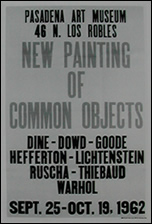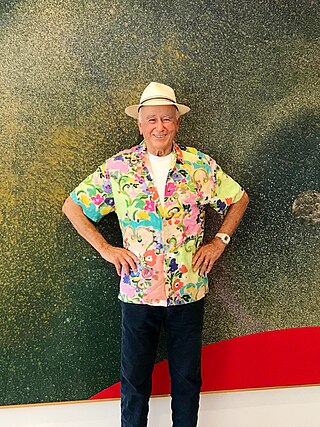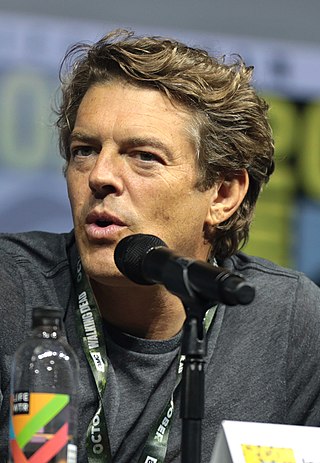Events from the year 1962 in art.
Wallace "Wally" Berman was an American experimental filmmaker, assemblage, and collage artist and a crucial figure in the history of post-war California art.

Edward Ralph Kienholz was an American installation artist and assemblage sculptor whose work was highly critical of aspects of modern life. From 1972 onwards, he assembled much of his artwork in close collaboration with his artistic partner and fifth wife, Nancy Reddin Kienholz. Throughout much of their career, the work of the Kienholzes was more appreciated in Europe than in their native United States, though American museums have featured their art more prominently since the 1990s.
Edward Joseph Ruscha IV is an American artist associated with the pop art movement. He has worked in the media of painting, printmaking, drawing, photography, and film. He is also noted for creating several artist's books. Ruscha lives and works in Culver City, California.

The Gagosian Gallery is a modern and contemporary art gallery owned and directed by Larry Gagosian. The gallery exhibits some of the most well-known artists of the 20th and 21st centuries. As of 2024, Gagosian employs 300 people at 19 exhibition spaces – including New York City, London, Paris, Basel, Beverly Hills, San Francisco, Rome, Athens, Geneva, and Hong Kong – designed by architects such as Caruso St John, Richard Gluckman, Richard Meier, Jean Nouvel, and Annabelle Selldorf.
Walter "Chico" Hopps was an American museum director, gallerist, and curator of contemporary art. Hopps helped bring Los Angeles post-war artists to prominence during the 1960s, and later went on to redefine practices of curatorial installation internationally. He is known for contributing decisively to “the emergence of the museum as a place to show new art.”
John Altoon was an American artist. Born in Los Angeles to immigrant Armenian parents, from 1947 to 1949 he attended the Otis Art Institute, from 1947 to 1950 he also attended the Art Center College of Design in Los Angeles, and in 1950 the Chouinard Art Institute. Altoon was a prominent figure in the LA art scene in the 1950s and 1960s. Exhibitions of his work have been held at the Museum of Contemporary Art San Diego, Whitney Museum of American Art, New York, Corcoran Gallery, Washington D.C, Fine Arts Museums of San Francisco, The Baxter Museum, Pasadena, and The Los Angeles County Museum of Art.

The exhibition "New Painting of Common Objects" at the Pasadena Art Museum in 1962 was the first museum survey of American pop art in the United States. The eight artists included were: Roy Lichtenstein, Jim Dine, Andy Warhol, Phillip Hefferton, Robert Dowd, Edward Ruscha, Joe Goode and Wayne Thiebaud. It was curated by Walter Hopps, who had given Andy Warhol his first solo show at the Ferus Gallery in Los Angeles the previous year. The show helped the pop art movement gain critical acceptance, preceding the Guggenheim Museum's 1963 pop art exhibition "Six Painters and the Object", curated by Lawrence Alloway.

Billy Al Bengston was an American visual artist and sculptor who lived and worked in Venice, California, and Honolulu, Hawaii. Bengston was probably best known for work he created that reflected California's "Kustom" car and motorcycle culture. He pioneered the use of sprayed layers of automobile lacquer in fine art and often used colors that were psychedelic and shapes that were mandala-like. ARTnews referred to Bengston as a "giant of Los Angeles's postwar art scene."

Nancy Reddin Kienholz was an American mixed media artist based in Hope, Idaho. She worked in installation art, assemblage, photography, and lenticular printing. She was most famous for her collaborations with her husband and creative partner Edward Kienholz, from their meeting in 1972 until his sudden death in 1994. She continued to produce her own artworks for the rest of her life.
Ed Moses was an American artist based in Los Angeles and a central figure of postwar West Coast art.

The Cool School is a 2008 American documentary film about the rise of the Los Angeles contemporary art scene. It was directed by Morgan Neville and narrated by Jeff Bridges. The documentary premièred at the Cleveland International Film Festival.

Jason Ferus Blum is an American producer. He is founder and CEO of Blumhouse Productions, which has produced the horror franchises Paranormal Activity (2007–2021), Insidious (2010–2023), The Purge (2013–2021), and Halloween (2018–2022). Blum has also produced Sinister (2012), Oculus (2013), Whiplash (2014), The Gallows (2015), The Gift (2015), Hush (2016), Split (2016), Ouija: Origin of Evil (2016), Get Out (2017), Happy Death Day (2017), Upgrade (2018), Us (2019), The Invisible Man (2020), Freaky (2020), The Black Phone (2021), M3GAN (2022), Five Nights at Freddy's (2023), and Speak No Evil (2024).
Syndell Studio was an art gallery located in the Brentwood neighborhood of Los Angeles, California, between 1954 and 1956.
The Huysman Gallery was an art gallery in Los Angeles, California that operated from December 1960 to summer 1961. It was located at 740 North La Cienega Boulevard, across the street from the noted Ferus Gallery. Curator Henry Hopkins, who founded the gallery, named it after the French decadent novelist Joris-Karl Huysmans. The gallery showcased the works of several young artists who later had great success, including Joe Goode, Ed Ruscha, and Larry Bell.
Riko Mizuno is a gallerist, art dealer, and artist. Born in Tokyo, Japan, she moved to Los Angeles in the 1950s to study ceramics at Chouinard Art Institute. Between 1966 and 1984, Mizuno operated galleries at three locations in Los Angeles.

BLUM is a contemporary art gallery located in Los Angeles, Tokyo, and New York.

Hassel Smith was an American painter.
Daniel Joel Tull is a contemporary American painter, sculptor and musician who lives and works in Los Angeles.
Shirley Neilsen Blum, also known as Shirley Hopps is an American art historian, author, gallerist, and professor emeritus at the State University of New York, Purchase (1970–1989). She specializes in Northern Renaissance art, early Netherlandish art, and modern art. In the 1950s through the 1960s, she was active in the Los Angeles gallery scene, and she co-founded and co-ran Ferus Gallery.










